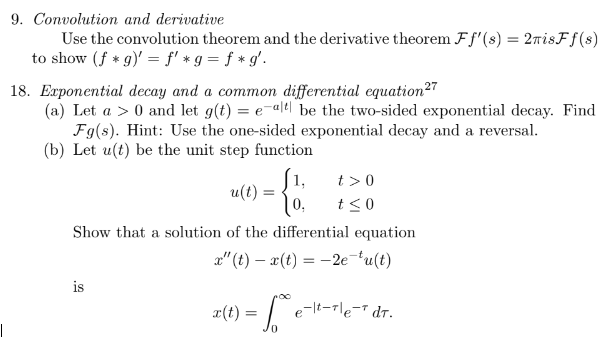Convolution and Differential Theorems Homework Answers Needed
Your Question:

9. Convolution and derivative Use the convolution theorem and the derivative theorem Ff'(s) = 2ñisƑƒ(s) to show (fg)' f' g=fg'.
18. Exponential decay and a common differential equation27
(a) Let a > 0 and let g(t) = e-alt be the two-sided exponential decay. Find
Fg(s). Hint: Use the one-sided exponential decay and a reversal.
(b) Let u(t) be the unit step function u(t): 1, t> 0 t≤0 Show that a solution of the differential equation x"(t)x(t)=-2e-¹u(t) ax(t) = √ e-lt-le- dr.
Step By Step Answers with Explanation
Sure, let's break down the steps for solving the given problems step by step with proper explanations:
\((fg)' = f'g + fg'\)
Now, let's compute the Fourier transforms of \(f'g\) and \(fg'\):
\(= -4\pi^2 s F[f(t)] F[g(t)]\)
2. Fourier Transform of \(fg'\):
As we can see, both \(F[f'g(s)]\) and \(F[fg'(s)]\) are equal to \(-4\pi^2 s F[f(t)] F[g(t)]\), which means that the Fourier transforms of \(f'g\) and \(fg'\) are equal.
Since the Fourier transforms of \(f'g\) and \(fg'\) are equal, it follows that \((fg)' = f' g\).
\(F[g(s)] = \int_{-\infty}^{\infty} e^{-st} e^{-at} dt\)
\(= \int_{-\infty}^{\infty} e^{-(s+a)t} dt\)
\(x(t) = \sqrt{\frac{1}{a}} \int_{-\infty}^{t} e^{-\frac{t - \tau}{a}} e^{-\tau} d\tau\)
Where \(a > 0\) is the constant from the exponential decay and \(u(t)\) is the unit step function. The integral represents the convolution of the one-sided exponential decay \(e^{-\frac{t - \tau}{a}}\) and the unit step function \(u(\tau)\). The factor \(\sqrt{\frac{1}{a}}\) is included to scale the solution correctly.





